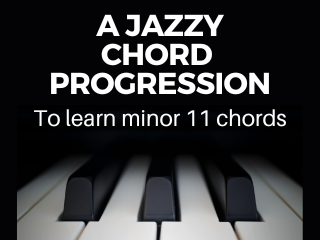The following two tabs change content below.


Greg Lee
Hi, my name is Greg Lee. I'm the creator of the Color Score Professional/Visual Chord Learning System. I love to share ideas and concepts about piano and keyboard playing in all styles of music. I believe the key to learning is having fun and making complicated things simple with visual tools and illustrations.
Latest posts by Greg Lee (see all)
- What is a minor/Major 7 Chord? - October 26, 2023
- 7 Chord Substitutions that Professionals Use - October 19, 2023
- 5 Simple Chord Tricks to Sound Amazing - October 5, 2023


 chords, you know they have a unique sound. You can easily learn to play this jazzy sounding chord progression with this 11th chord voicing.
chords, you know they have a unique sound. You can easily learn to play this jazzy sounding chord progression with this 11th chord voicing. Play this C minor chord in your left hand.
Play this C minor chord in your left hand.
 On this B flat tone, build a Major chord which is B flat Major. A Major chord consists of the root, 3rd and 5th tones.
On this B flat tone, build a Major chord which is B flat Major. A Major chord consists of the root, 3rd and 5th tones. The result of these two triads is this minor 11th chord voicing.
The result of these two triads is this minor 11th chord voicing.
 This is referred to as an upper structure triad. The upper structure concept is simply a way of defining the upper notes of an extended chord that are those of a Major or minor triad.
This is referred to as an upper structure triad. The upper structure concept is simply a way of defining the upper notes of an extended chord that are those of a Major or minor triad. Notice that the two triads the F minor 11 chord is composed of are not in root position like the two chords that compose the Cm11 chord. They’re both in 2nd inversion.
Notice that the two triads the F minor 11 chord is composed of are not in root position like the two chords that compose the Cm11 chord. They’re both in 2nd inversion. A flat minor 11. (G flat Major over A flat minor)
A flat minor 11. (G flat Major over A flat minor) B minor 11 (A Major over B minor)
B minor 11 (A Major over B minor)
 A minor 11 (G Major over A minor)
A minor 11 (G Major over A minor)
 D flat minor 11 (B Major over D flat minor)
D flat minor 11 (B Major over D flat minor)

